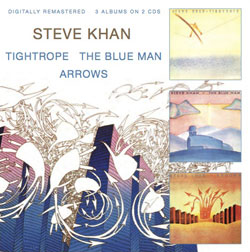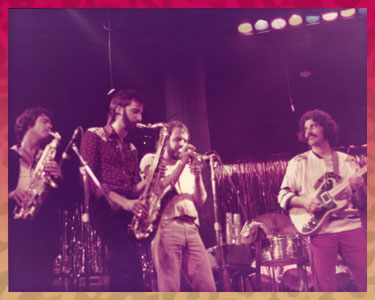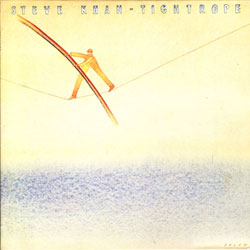Steve Khan's lead sheet:
"The Big Ones"(Randy Brecker)
When, in March of 2015, BGO Records(UK) reissued my first three albums as a leader "TIGHTROPE"(1977) "THE BLUE MAN"(1978), and "ARROWS"(1979), it was one of those rare events during my life in the music business where this kind of good fortune seemed to be smiling down upon me. In the 35 years that have passed since those recordings, I rarely, if ever, listen to them, but having been allowed to be a modest participant in the reissue process, I did have to spend some time listening to these mixes and masters in hopes of trying to bring the new audio treatments into the new century. It's never easy to do this, but, generally speaking, who would know the subtleties of the original recordings and mixes better than the artist? In my opinion, NO ONE! As I reviewed the original tunes that had been presented at KHAN'S KORNER 2, I realized that I had never gotten around to presenting one of my favorite tunes from "TIGHTROPE," and that was Randy Brecker's brilliant tune, "The Big Ones." I did have to spend some time listening to these mixes and masters in hopes of trying to bring the new audio treatments into the new century. It's never easy to do this, but, generally speaking, who would know the subtleties of the original recordings and mixes better than the artist? In my opinion, NO ONE! As I reviewed the original tunes that had been presented at KHAN'S KORNER 2, I realized that I had never gotten around to presenting one of my favorite tunes from "TIGHTROPE," and that was Randy Brecker's brilliant tune, "The Big Ones."
During my years as part of The Brecker Bros. Band, which preceded my first three recordings for Columbia Records, there was no question that the influence of Randy's compositions was profound, and it has stayed with me throughout my career. And so, as I was preparing for "TIGHTROPE," I asked Randy if he might have an 'extra' tune that didn't seem to fit on a forthcoming Brecker Bros. recording, and would he let me record it? I remembered that we had once rehearsed "The Big Ones" while getting ready for "BACK TO BACK"(1976), and so I knew that I wanted that tune for my album, IF Randy would let me have it. What strikes me now, if memory serves, is that I believe that Randy originally wrote this tune in Ab minor. As you will see and hear, I raised the key up a half-step to A minor, as I thought that this would add an extra funky element for Will Lee to have the usage of his open strings, especially the 'A' and 'E' strings. 1977 was several years ahead of the invention and perfection of the 5-bring electric bass, which would have certainly provided a low Eb for the original key. In writing out a newly revised version of the lead sheet, I was amazed that I could fit everything onto 2 pages, though probably 3 would have been better, thus eliminating double-codas and other musical directions.
For anyone who has been visiting these pages since the launching of the website in 1998, it is common knowledge that over the course of the 3 Columbia albums, I was trying to keep aspects of the original sound and feeling of the Brecker Bros. Band alive. One of the most important elements was always having a tune or two that would feature the spectacular sound of the mini-horn section, consisting of: Randy Brecker(Trumpet); David Sanborn(Alto Sax); and Michael
Brecker(Tenor Sax). Beyond the brilliance of Randy's arranging skills, the ensemble chemistry that these three horn giants created was so spectacular that I still marvel when I hear them play a section like letter [B] of "The Big Ones." If you remove all the harmonies, the slash-chords, and just sing the melody to yourself, it is actually almost childishly simple, and therein lies its particular genius. When preparing the horn charts for the recording, I remember that Randy and I agreed that for this section, it would be best if we made a shift in the usual way the notes were assigned, and this time David's alto sax would assume the top melodic voice, and Randy would be tucked in the middle, with Mike as the lower voice. This section appears 3 times during the course of the recorded version, and each time it's a real joy to hear. As we always did in those days, the horns were double-tracked and placed on opposite sides of the stereo field. Randy, David, and Michael knew exactly how to blend with one another, and how to phrase as one. Their internal dynamics, within any phrase, are perhaps the best that one can imagine. At a funky tempo like this one, their short 8th-notes are exactly the thing which has influenced arrangers and other horn sections the world over. This alone make me so very proud to have been a part of this group, and their legacy of ensemble horn playing. At a funky tempo like this one, their short 8th-notes are exactly the thing which has influenced arrangers and other horn sections the world over. This alone make me so very proud to have been a part of this group, and their legacy of ensemble horn playing.
During the mid-'70s, Will Lee was one of the first electric bassists to apply the Funk Machine pedal, an early envelope following device, to his personal sound arsenal. "The Big Ones" became the perfect vehicle to feature Will's great feel on the bass. Normally, with that sound occupying such a huge role on this tune, I would try to stay away from it myself, but it just seemed like using the MXR Touch-Wah was the right thing to do to state Randy's ultra-simple, but very funky melody. To add to the R&B sounds that permeate the piece, Don Grolnick added his special touch on the clavinet, while Bob James contributed the sense of romance via his wonderful Fender Rhodes playing. One of the most wonderful things about working with percussionist Ralph MacDonald over the years was that he hears the contributions of his instruments like a producer. One can have concepts and ideas about what you might want him to play, but as he listens to a song, he's developing his own sense of what he feels is the right way to color it. He had such great instincts about this, and as part of his work method, he knows when to lay-out too. When he does play during the [A] sections, he's lightly playing conga, yet he does not play during the letter [B] at all. When David Sanborn's alto sax solo begins, Ralph adds a touch of double-time from the conga, and a shaker as well. After a reprise of [B], when the guitar solo begins, Ralph shifts to a cowbell on the quarter-notes, and the conga continues as before. With one last repeat of [B] and final statement of the [A] melody, Ralph helps to drive the tune home by staying on the cowbell alongside his conga. It is all so tastefully done!
Drummer Steve Gadd also contributed something very special to this tune, adding to the character and shape of the piece. I could be wrong about this, but I recall that after a couple of run-throughs, we were not quite happy with how we were treating letter [B], and it might well have been Bob James' suggestion that Steve try some kind of street beat with a military snare drum twist to it. Of course, as he is a master of all the snare drum rudiments, Steve came-up with something completely unique and brilliant. One can't help but notice that with each appearance of this section, Steve's playing is looser, and looser, and more interactive with everything that's going on above him. This remains as another one of my favorite aspects to the arrangement of Randy's great tune.
There are many other little arranging touches that help to make what is a very simple tune, with only two melodic sections, be able to sustain itself for some 6-minutes. I'll give you some examples that were fascinating to me as I began to revisit the old lead sheet. Firstly, in between the statement of [A] and [A2], you have a reprise of Will Lee's bass intro, [I2]. Then, after [B] and another repeat of [A3], there is a great [Solo Break] for a pick-up by David Sanborn. This is always a most effective device when it appears at the just the right moment. Silence from the rhythm section can speak volumes. When my guitar arrives later, we go directly to it from the crescendo out of the last bar of [B]. The final touch to the performance, I believe that it should be again credited to Bob James. If my memory has not become too foggy, I believe that I arrived at the session, and I did not originally have an ending for this tune. I think that Bob heard this particular ending after a couple of rehearsals in the studio, and perhaps one take. As the full horn section was done on an overdub date, I am pretty certain that Bob also added the little figures that the horns play in the final 3 bars to drive the tune to its final hit. I am so very grateful to everyone for what they added to the tune. Then, after [B] and another repeat of [A3], there is a great [Solo Break] for a pick-up by David Sanborn. This is always a most effective device when it appears at the just the right moment. Silence from the rhythm section can speak volumes. When my guitar arrives later, we go directly to it from the crescendo out of the last bar of [B]. The final touch to the performance, I believe that it should be again credited to Bob James. If my memory has not become too foggy, I believe that I arrived at the session, and I did not originally have an ending for this tune. I think that Bob heard this particular ending after a couple of rehearsals in the studio, and perhaps one take. As the full horn section was done on an overdub date, I am pretty certain that Bob also added the little figures that the horns play in the final 3 bars to drive the tune to its final hit. I am so very grateful to everyone for what they added to the tune.
It remains as one of my great regrets, where the recording of "The Big Ones" is concerned, and that is that I changed one of Randy's chords from an Emaj7#5, to simply pumping on Am7 in bar 4 of each [A] section. Perhaps it was overkill, but Randy had that chord appearing on the and-of-2 in that bar each time that it appeared. Now, the only time that this sonority appears in the tune is during the last bar of each [B] section. I still don't know why, but at that time, after so many years of playing Randy's music, I just couldn't "hear" a major7#5 as the V7 chord to the i minor tonic. As a tribute to Randy's original concept, I have added in that chord parenthetically to bar 4 of letter [A].
I wish that I actually knew or understood what the motivating factor was for Andy Gray and BGO Records to have decided that they were going to package my three Columbia albums together on 2 CDs for a reissue. I just know that I am very grateful that it happened. As I have written in several pages at this website, when one does not own their recordings, the artist has no rights, where being informed of any plans the label might have are concerned. Fans tend to think that we, as artists, have something to say about all this, but, we do not!!! So, for all I know, this could be the last chance that fans of this music will have to own these recordings and these performances on an actual CD. I have done everything possible to try to make the audio sound as good as it can, and to have the look of the package be relatively consistent with what fans have come to expect from me. I am hoping that everyone will be pleased with what they see and hear. One example of a most generous "bonus" from BGO Records was that they gave this reissue a 24-page CD booklet that includes 12 pages of liner notes! No one was more surprised about that than me!!!
[Photo: Steve w/ David Sanborn; Michael Brecker; and Randy Brecker,
taken by Erika Price @ the Village Gate ca. '75]
|

